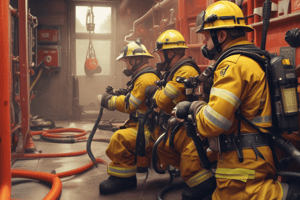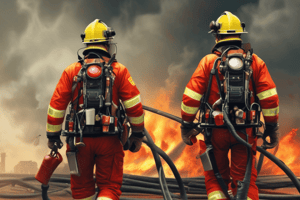Podcast
Questions and Answers
What is a potential safety concern when dealing with clogged connections?
What is a potential safety concern when dealing with clogged connections?
- Slippery surfaces
- Poor lighting
- Noise pollution
- Biohazardous materials (correct)
What tool can be used to clear debris from a clogged connection?
What tool can be used to clear debris from a clogged connection?
- Wrench
- Pliers
- Needle nose pliers (correct)
- Hacksaw
What is the purpose of using a Double Female adapter in a hose connection?
What is the purpose of using a Double Female adapter in a hose connection?
- To reduce friction loss
- To connect to an interior standpipe valve (correct)
- To connect two hoses together
- To increase water pressure
What may happen if you pump into an FDC or an interior standpipe connection at a lower pressure than the building fire pump is producing?
What may happen if you pump into an FDC or an interior standpipe connection at a lower pressure than the building fire pump is producing?
Why might a 38mm female to 65mm male Increaser not connect in a hose cabinet?
Why might a 38mm female to 65mm male Increaser not connect in a hose cabinet?
What is the maximum apparatus pump pressure allowed when pumping into an FDC?
What is the maximum apparatus pump pressure allowed when pumping into an FDC?
What problem can a seized female swivel cause during a hose setup?
What problem can a seized female swivel cause during a hose setup?
In a Class 2 system, what adapter is required to connect to a 65mm connection?
In a Class 2 system, what adapter is required to connect to a 65mm connection?
What is the primary reason why TFS apparatus may not be able to pump the pressures required to reach upper floors in tall buildings?
What is the primary reason why TFS apparatus may not be able to pump the pressures required to reach upper floors in tall buildings?
Why are crews heavily reliant on building systems when pumping into an FDC?
Why are crews heavily reliant on building systems when pumping into an FDC?
What must be done before connecting to an FDC?
What must be done before connecting to an FDC?
Who makes the decision to charge the FDC at 1400 kPa?
Who makes the decision to charge the FDC at 1400 kPa?
What is the minimum number of 65mm hose lengths required from the floor below the fire floor to achieve proper flow rates with a nozzle pressure of 350 kPa?
What is the minimum number of 65mm hose lengths required from the floor below the fire floor to achieve proper flow rates with a nozzle pressure of 350 kPa?
What is the friction loss per 15m length of 65mm hose?
What is the friction loss per 15m length of 65mm hose?
What is the purpose of connecting to the Fire Department Connection (FDC) at every confirmed fire?
What is the purpose of connecting to the Fire Department Connection (FDC) at every confirmed fire?
What is the maximum distance allowed between a hydrant and a Fire Department Connection (FDC)?
What is the maximum distance allowed between a hydrant and a Fire Department Connection (FDC)?
What happens when the hose lines to the FDC are charged?
What happens when the hose lines to the FDC are charged?
What is a potential issue when trying to supply a building's standpipe system via the FDC?
What is a potential issue when trying to supply a building's standpipe system via the FDC?
What is the primary function of a Pressure Restricting Device (PRD)?
What is the primary function of a Pressure Restricting Device (PRD)?
What is the minimum rated flow required for a Class 3 Standpipe System according to NFPA 14?
What is the minimum rated flow required for a Class 3 Standpipe System according to NFPA 14?
What is the purpose of the 38mm outlet on a standpipe?
What is the purpose of the 38mm outlet on a standpipe?
What is the residual pressure requirement for buildings in Ontario?
What is the residual pressure requirement for buildings in Ontario?
What is a safety concern related to the hose and nozzle present in Class 2 and 3 systems?
What is a safety concern related to the hose and nozzle present in Class 2 and 3 systems?
What is the minimum rated flow that a Class 1 standpipe system is required to deliver at the two uppermost or hydraulically most remote outlets?
What is the minimum rated flow that a Class 1 standpipe system is required to deliver at the two uppermost or hydraulically most remote outlets?
What is the residual pressure requirement for a Class 1 standpipe system in Ontario, as per the Ontario Building Code?
What is the residual pressure requirement for a Class 1 standpipe system in Ontario, as per the Ontario Building Code?
What is the primary location of a Class 1 standpipe system?
What is the primary location of a Class 1 standpipe system?
What is a characteristic of a Class 2 standpipe system?
What is a characteristic of a Class 2 standpipe system?
What is the difference in residual pressure requirement for a Class 1 standpipe system pre-1993 and post-1993?
What is the difference in residual pressure requirement for a Class 1 standpipe system pre-1993 and post-1993?
What is a critical factor in determining the type of standpipe system required for a building?
What is a critical factor in determining the type of standpipe system required for a building?
What is the primary purpose of a pressure reducing valve (PRV) in a standpipe system?
What is the primary purpose of a pressure reducing valve (PRV) in a standpipe system?
What is unique about a Class 1 standpipe system?
What is unique about a Class 1 standpipe system?
What is a common issue that may occur when connecting to a standpipe system?
What is a common issue that may occur when connecting to a standpipe system?
What is a key consideration when operating a standpipe valve?
What is a key consideration when operating a standpipe valve?
Under what pressure conditions are PRDs installed?
Under what pressure conditions are PRDs installed?
What is a characteristic of most PRDs?
What is a characteristic of most PRDs?
What type of valve is designed to actively regulate outlet pressures in both static and flowing conditions?
What type of valve is designed to actively regulate outlet pressures in both static and flowing conditions?
What is a characteristic of some PRVs?
What is a characteristic of some PRVs?
What term is applied to PRVs that can be easily adjusted?
What term is applied to PRVs that can be easily adjusted?
When dealing with a drained standpipe system, what may be utilized to obtain a water supply to upper floors?
When dealing with a drained standpipe system, what may be utilized to obtain a water supply to upper floors?
What is the purpose of removing PRDs in PRD equipped buildings?
What is the purpose of removing PRDs in PRD equipped buildings?
What is the minimum vertical height that can be covered by one length of hose in a residential occupancy?
What is the minimum vertical height that can be covered by one length of hose in a residential occupancy?
What is the recommended pressure for pumping into an improvised standpipe system?
What is the recommended pressure for pumping into an improvised standpipe system?
What type of standpipe system is designed to be filled quickly?
What type of standpipe system is designed to be filled quickly?
What can be used to clear debris from a clogged FDC connection?
What can be used to clear debris from a clogged FDC connection?
What is the purpose of using a Double Female adapter in a hose connection?
What is the purpose of using a Double Female adapter in a hose connection?
What issue can arise if a seized female swivel is not addressed?
What issue can arise if a seized female swivel is not addressed?
What equipment is required when connecting to a 65mm connection on the main floor in a Class 2 system?
What equipment is required when connecting to a 65mm connection on the main floor in a Class 2 system?
Where is the 65mm connection typically located in a Class 1 standpipe system?
Where is the 65mm connection typically located in a Class 1 standpipe system?
What is the correct order of attachment for a Class 2 Standpipe System?
What is the correct order of attachment for a Class 2 Standpipe System?
What is the purpose of the 65mm (forty five degree) elbow with drain in a Class 2 Standpipe System?
What is the purpose of the 65mm (forty five degree) elbow with drain in a Class 2 Standpipe System?
What is the recommended method for connecting the 38mm hose to the outlet in a Class 2 Standpipe System?
What is the recommended method for connecting the 38mm hose to the outlet in a Class 2 Standpipe System?
What is the primary concern when the outlet does not allow clearance for the 38mm female to 65mm male Increaser?
What is the primary concern when the outlet does not allow clearance for the 38mm female to 65mm male Increaser?
What is the function of the 65mm In-Line Pressure Gauge in a Class 2 Standpipe System?
What is the function of the 65mm In-Line Pressure Gauge in a Class 2 Standpipe System?
What is the purpose of removing the 65mm outlet cap PRV in a Class 2 Standpipe System?
What is the purpose of removing the 65mm outlet cap PRV in a Class 2 Standpipe System?
What is the correct procedure for attaching the 65mm hose to the 65mm (forty five degree) elbow with drain?
What is the correct procedure for attaching the 65mm hose to the 65mm (forty five degree) elbow with drain?
What is the primary reason for inspecting the outlet for debris in a Class 2 Standpipe System?
What is the primary reason for inspecting the outlet for debris in a Class 2 Standpipe System?
What is the function of the 65mm Gate Valve in a Class 2 Standpipe System?
What is the function of the 65mm Gate Valve in a Class 2 Standpipe System?
What is the purpose of attaching the 65mm (sixty degree) yellow elbow before or after the Gate Valve in a Class 2 Standpipe System?
What is the purpose of attaching the 65mm (sixty degree) yellow elbow before or after the Gate Valve in a Class 2 Standpipe System?
Flashcards are hidden until you start studying
Study Notes
Standpipe Systems
- Standpipe systems are found in high-rise buildings, low-rise buildings, tunnels, and other occupancies
- The system consists of a network of pipes, valves, and outlets that supply water to various floors and areas of a building
Types of Standpipe Systems
- Class 1 Standpipe System:
- Required to deliver a minimum rated flow of 1892 L/min at the two uppermost or hydraulically most remote outlets at 450 kPa residual pressure pre-1993 and 700 kPa residual pressure post-1993
- Typically located in stairwells and equipped with 65mm hose connection and FDC
- Found in high-rise buildings
- Ontario only requires minimum pressure of 450 kPa and 30 litres/second (1800 L/min)-OBC
- FDC and fire pump
- Class 2 Standpipe System:
- Required to deliver a minimum rated flow of 380 L/min at the two uppermost or hydraulically most remote outlets at 450 kPa residual pressure pre-1993 and 700 kPa residual pressure post-1993
- Fed by domestic city water pressure
- Equipped with only 38mm hose connection and may not have a FDC or fire pump
- Class 3 Standpipe System:
- Required to deliver a minimum rated flow of 1892 L/min at the two uppermost or hydraulically most remote outlets at 450 kPa residual pressure pre-1993 and 700 kPa residual pressure post-1993
- Typically found in high-rise buildings
- Equipped with both 38mm and 65mm hose connections
- Ontario only requires minimum pressure of 450 kPa and 30 litres/second (1800 L/min)-OBC
- Do not use 38mm hose in cabinet
Pressure Restricting Devices (PRD) and Pressure Reducing Valves (PRV)
- Pressure Restricting Devices (PRD):
- Designed to reduce, regulate, and control or restrict water pressure in flowing conditions only
- Operate in a manner similar to a pump operator gating down at the pump panel
- Do not compensate for changes in input pressure to maintain a constant discharge pressure and do not control pressure in static conditions
- May be brazed into place- can't remove or Orifice plates not brazed- removed easily by hand
- Limiting devices:
- Pin type- removed (allen key) or sheered with pipe wrench
- Metal clip- remove by pulling with hand
- Mechanical- By hand or hose spanner
- Pressure Reducing Valves (PRV):
- Active valves that regulate outlet pressures in both static and flowing conditions
- Required for outlets where static pressures exceed 1225 kPa
- Some PRVs are factory pre-set and cannot be adjusted while others can be adjusted with the proper tools
- PRV types:
- Field Adjustable- 75 lbs of torque required
- Fireground Adjustable- 15 lbs o torque required
Fire Department Connection (FDC)
- Typically found on the exterior of buildings equipped with standpipe systems
- Consists of two 65mm female swivel connections (Siamese connection)
- Connection must be labelled as to whether it supports the standpipe system or the sprinkler system
- Must be located within 45m of a hydrant and have an unobstructed view to the hydrant
Connecting to Standpipe Systems
- Class 1 Standpipe:
- Connect 65mm hose to 65mm outlet
- Use 65mm Gate Valve and 65mm In-Line Pressure Gauge
- Class 2 Standpipe:
- Remove 38mm hose from outlet and remove debris
- Attach 38mm female to 65mm male Increaser and 65mm (sixty degree) yellow elbow
- Connect 65mm Gate Valve and 65mm In-Line Pressure Gauge
Troubleshooting FDC Problems
- Clogged Connection:
- Debris can be found inside the FDC and shall be removed prior to connecting hose lines
- Use needle nose pliers or a similar tool to clear the connection
- Seized Cap:
- If one threaded cap is seized, utilize the other connection
- Use a Double Female adapter to connect another hose line to an interior standpipe valve (non-PRV) 65mm connection
- Seized Female Swivel:
- Present connection issues
- Use a 38mm female to 65mm male Increaser and 65mm (sixty degree) yellow elbow
Studying That Suits You
Use AI to generate personalized quizzes and flashcards to suit your learning preferences.



